Tectonic Inversion and Deformation Differences in the Transition from Ionian Basin to Apulian Platform: The Example from Ionian Islands, Greece
Abstract
:1. Introduction
2. Geological Setting
3. Material and Methods
4. Results
- In relation to the current relief
- In relation to the depositional conditions during the extensional regime
- In relation to the distance from the Kefalonia transform fault
- In relation to Triassic evaporites
- In relation to the age of inversion activity
- In relation to the thrusts and deformation structures
- Comparing all the above in four cross-sections
5. Discussion
6. Conclusions
Author Contributions
Funding
Data Availability Statement
Conflicts of Interest
References
- Ziegler, P.A. Evolution of the Arctic-North Atlantic and the Western Tethys. AAPG Mem. 1988, 43, 198. [Google Scholar]
- Basilone, L. Seismogenic rotational slumps and translational glides in pelagic deep-water carbonates. Upper Tithonian-Berriasian of Southern Tethyan margin (W Sicily, Italy). Sediment. Geol. 2017, 356, 1–14. [Google Scholar] [CrossRef]
- Basilone, L.; Sulli, A. Basin analysis in the Southern Tethyan margin: Facies sequences, stratal pattern and subsidence history highlight extension to inversion processes in the Cretaceous Panormide carbonate platform (NW Sicily). Sediment. Geol. 2018, 363, 235–251. [Google Scholar] [CrossRef]
- Cooper, M.A.; Warren, M.J. Inverted fault systems and inversion tectonic settings. In Regional Geology and Tectonics, Principles of Geologic Analysis, 2nd ed.; Scarselli, N., Adam, J., Chiarella, D., Roberts, D.G., Bally, A.W., Eds.; Elsevier: Amsterdam, The Netherlands, 2020; Volume 1, pp. 169–204. [Google Scholar]
- Brekke, H.; Riis, F. Tectonics and basin evolution of the Norwegian shelf between 62°N and 72°N. Nor. Geol. Tidsskr. 1987, 67, 295–322. [Google Scholar]
- Doré, A.G.; Lundin, E.R.; Jensen, L.N.; Birkeland, Ø.; Eliassen, P.E.; Fichler, C. Principal tectonic events in the evolution of the northwest European Atlantic margin. In Petroleum Geology of Northwest Europe: Proceedings of the 5th Conference; The Geological Society of London: London, UK, 1997; pp. 41–61. [Google Scholar]
- Price, S.; Brodie, J.; Whitham, A.; Kent, R.A.Y. Mid-Tertiary rifting and magmatism in the Traill Ø region, East Greenland. J. Geol. Soc. 1997, 154, 419–434. [Google Scholar] [CrossRef]
- Dore, A.G.; Lundin, E.R. Cenozoic compressional structures on the NE Atlantic margin; nature, origin and potential significance for hydrocarbon exploration. Pet. Geosci. 1996, 2, 299–311. [Google Scholar] [CrossRef]
- Arthaud, F.; Choukroune, P.; Robineaue, B. Evolution structurale de la zone transformante d’Arta (République de Djibouti). Bull. Soc. Geol. Fr. 1980, 22, 909–915. [Google Scholar] [CrossRef]
- Gaulier, J.M.; Huchon, P. Tectonic evolution of Afar triple junction. Bull. Soc. Geol. 1991, 162, 451–464. [Google Scholar] [CrossRef]
- Ring, U. The influence of preexisting structure on the evolution of the Cenozoic Malawi rift (East African rift system). Tectonics 1994, 13, 313–326. [Google Scholar] [CrossRef]
- Morley, C.K.; Cunningham, S.M.; Harper, R.M.; Wescott, W.A. Geology and geophysics of the Rukwa Rift, East Africa. Tectonics 1992, 11, 69–81. [Google Scholar] [CrossRef]
- Morley, C.K.; Wescott, W.A.; Harper, R.M.; Wigger, S.T.; Day, R.A.; Karanja, F.M. Geology and Geophysics of the Western Turkana Basins, Kenya. In Geoscience of Rift Systems—Evolution of East Africa, 2nd ed.; Morley, C.K., Ed.; AAPG Studies in Geology: Tulsa, OK, USA, 1999; Volume 44, pp. 19–54. [Google Scholar]
- Ring, U.; Betzler, C.; Delvaux, D. Normal vs. strike-slip faulting during rift development in East Africa: The Malawi rift. Geology 1992, 20, 1015–1018. [Google Scholar] [CrossRef]
- Sakkas, V.; Kapetanidis, V.; Kaviris, G.; Spingos, I.; Mavroulid, S.; Diakakis, M.; Alexopoulos, J.D.; Kazantzidou-Firtinidou, D.; Kassaras, I.; Didalos, S.; et al. Seismological and Ground Deformation Study of the Ionian Islands (W. Greece) during 2014–2018, a period of Intense Seismic Activity. Appl. Sci. 2022, 12, 2331. [Google Scholar] [CrossRef]
- Zelilidis, A.; Piper, D.J.W.; Vakalas, J.; Avramidis, P.; Getsos, K. Oil and gas plays in Albania: Do equivalent plays exist in Greece? J. Pet. Geol. 2003, 26, 29–48. [Google Scholar] [CrossRef]
- Karakitsios, V.; Rigakis, N. Evolution and Petroleum Potential of Western Greece. J. Pet. Geol. 2007, 30, 197–218. [Google Scholar] [CrossRef]
- Bernoulli, D.; Renz, O. Jurassic carbonate facies and new ammonite faunas from western Greece: Eclog. Eclogae Geol. Helv. 1970, 63, 573–607. [Google Scholar]
- Karakitsios, V. Ouverture et Inversion Tectonique du Basin Ionien (Epire, Grèce). Ann. Géol. Pays Héllen 1992, 35, 185–318. [Google Scholar]
- van Hinsbergen, D.J.J.; van der Meer, D.G.; Zachariasse, W.J.; Meulenkamp, J.E. Deformation of western Greece during Neogene clockwise rotation and collision with Apulia. Int. J. Earth Sci. 2005, 95, 463–490. [Google Scholar] [CrossRef]
- Tankard, A.J.; Balkwill, H.R. Extensional Tectonics and Stratigraphy of the North Atlantic Margins; American Association of Petroleum Geologists: Tulsa, OK, USA, 1989; Volume Memoir 46, 641p. [Google Scholar]
- Jackson, M.P.A.; Vendeville, B.C. Regional extension as a geologic trigger for diapirism. Geol. Soc. Am. Bull. 1994, 106, 57–73. [Google Scholar] [CrossRef]
- Vendeville, B.C.; Nilsen, K.T. Episodic growth of salt diapirs driven by horizontal shortening. In Salt, Sediment, and Hydrocarbons: Society of Economic Paleontologists and Mineralogists Gulf Coast Section, 16th Annual Research Conference Program and Extended Abstracts, Los Angeles, CA, USA, December 1995; SEPM Society for Sedimentary Geology: Claremore, OK, USA, 1995; pp. 285–295. [Google Scholar]
- Vendeville, B.C.; Jackson, M.P.A. The fall of diapirs during thin-skinned extension. Mar. Pet. Geol. 1992, 9, 354–371. [Google Scholar] [CrossRef]
- Hudec, M.R.; Jackson, M.P.A. Terra infirma: Understanding salt tectonics. Earth-Sci. Rev. 2007, 82, 1–28. [Google Scholar] [CrossRef]
- Jackson, M.P.A.; Hudec, M.R. Salt Tectonics. In Principles and Practice; Cambridge University Press: Cambridge, UK, 2017; ISBN 978-1-107-01331-5. [Google Scholar]
- Zelilidis, A.; Papatheodorou, G.; Maravelis, A.; Christodoulou, D.; Tserolas, P.; Fakiris, E.; Dimas, X.; Georgiou, N.; Ferentinos, G. Interplay of thrust, back-thrust, strike-slip and salt tectonics in a Fold and Thrust Belt system: An example from Zakynthos Island, Greece. Int. J. Earth Sci. 2016, 105, 2111–2132. [Google Scholar] [CrossRef]
- Bourli, N.; Pantopoulos, G.; Maravelis, A.G.; Zoumpoulis, E.; Iliopoulos, G.; Pomoni-Papaioannou, F.; Kostopoulou, S.; Zelilidis, A. Late Cretaceous to early Eocene geological history of the eastern Ionian Basin, southwestern Greece: A sedimentological approach. Cretac. J. 2019, 98, 47–71. [Google Scholar] [CrossRef]
- Zelilidis, A.; Maravelis, A.G.; Tserolas, P.; Konstantopoulos, P.A. An overview of the Petroleum systems in the Ionian zone, onshore NW Greece and Albania. J. Pet. Geol. 2015, 38, 331–348. [Google Scholar] [CrossRef]
- Maravelis, A.; Makrodimitras, G.; Zelilidis, A. Hydrocarbon prospectivity in the Apulian platform and Ionian zone, in relation to strike-slip fault zones, foreland and back-thrust basins of Ionian thrust, in Greece. Oil Gas Eur. Mag. 2012, 38, 64–89. [Google Scholar]
- Tserolas, P.; Maravelis, A.; Pasadakis, N.; Zelilidis, A. Organic geochemical features of the Upper Miocene successions of Lefkas and Cephalonia islands, Ionian Sea, Greece: An integrated geochemical and statistical approach. Arab. J. Geosci. 2018, 11, 105. [Google Scholar] [CrossRef]
- Del Ben, A.; Mocnika, A.; Volpib, V.; Karvelis, P. Old domains in the South Adria plate and their relationship with the West Hell. front. J. Geodyn. 2015, 89, 15–28. [Google Scholar] [CrossRef]
- Avramidis, P.; Zelilidis, A. The nature of deep-marine sedimentation and palaeocurrent trends as an evidence of Pindos foreland basin fill conditions. Episodes 2001, 24, 252–256. [Google Scholar] [CrossRef] [PubMed]
- Kokinou, Ε.; Kamberis, Ε.; Vafidis, A.; Monopolis, D.; Ananiadis, G.; Zelilidis, A. Deep seismic reflection data from off-shore western Greece: A new crustal model for the Ionian Sea. J. Pet. Geol. 2005, 28, 81–98. [Google Scholar] [CrossRef]
- Karakitsios, V. Western Greece and Ionian Sea petroleum systems. AAPG 2013, 97, 1567–1594. [Google Scholar] [CrossRef]
- Accordi, G.; Carbone, F.; Di Carlo, M.; Pignatti, J. Microfacies analysis of deep-water breccia clasts: Shallow vs. deep-ramp Paleogene sedimentation in Cephalonia and Zakynhtos (Ionian Islands, Greece). Facies 2014, 60, 445–466. [Google Scholar] [CrossRef]
- Bourli, N.; Iliopoulos, G.; Zelilidis, A. Reassessing Depositional Conditions of the Pre-Apulian Zone Based on Synsedimentary Deformation Structures during Upper Paleocene to Lower Miocene Carbonate Sedimentation, from Paxoi and Anti-Paxoi Islands, Northwestern End of Greece. Minerals 2022, 12, 201. [Google Scholar] [CrossRef]
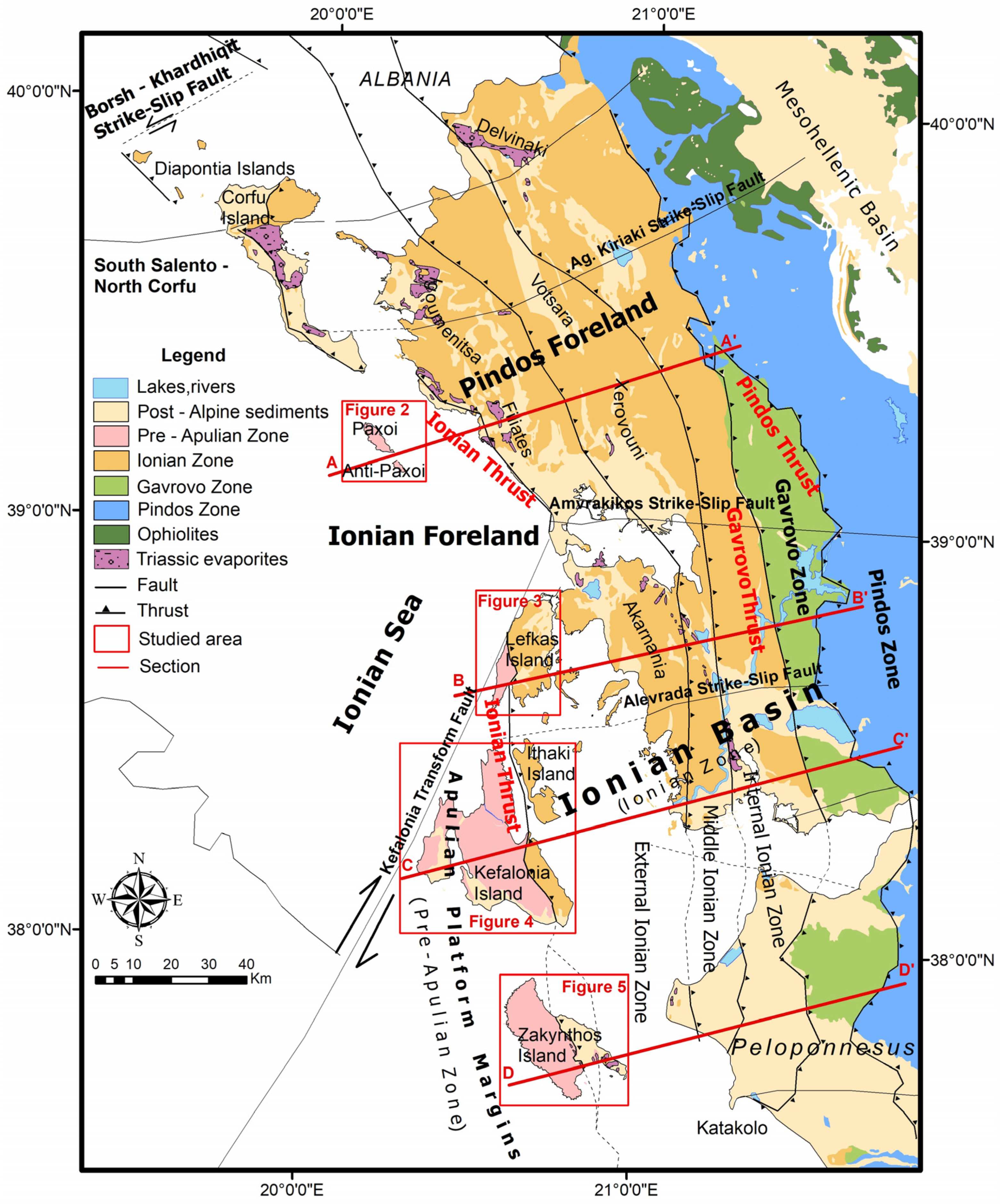


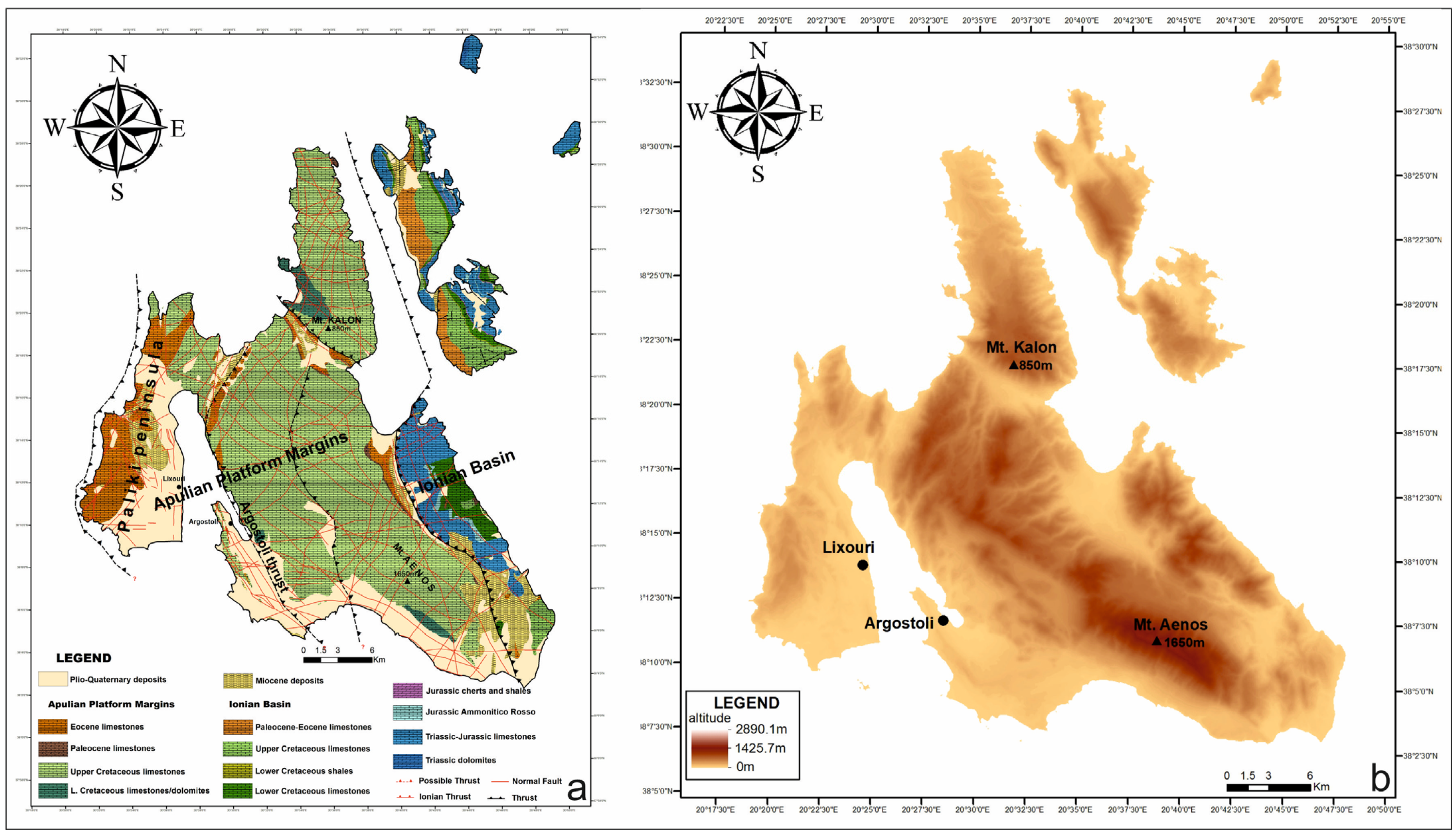
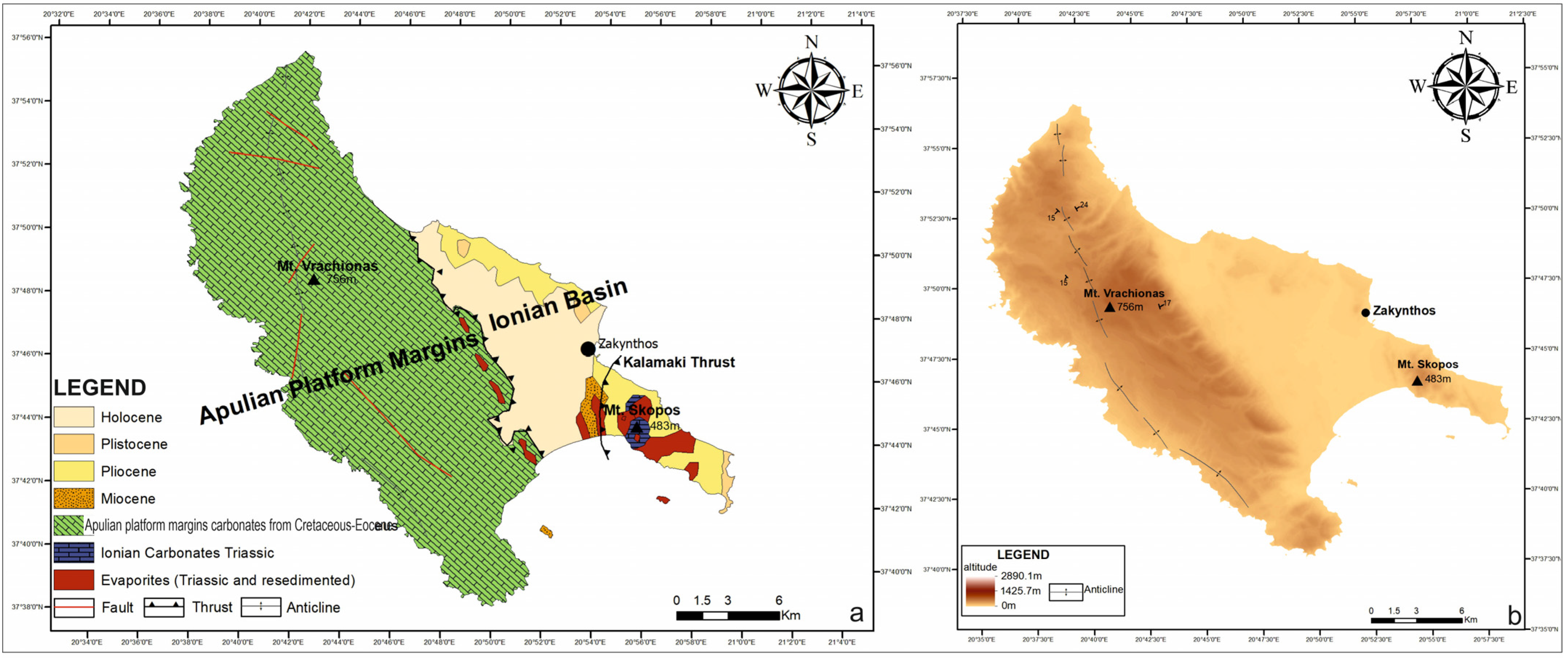
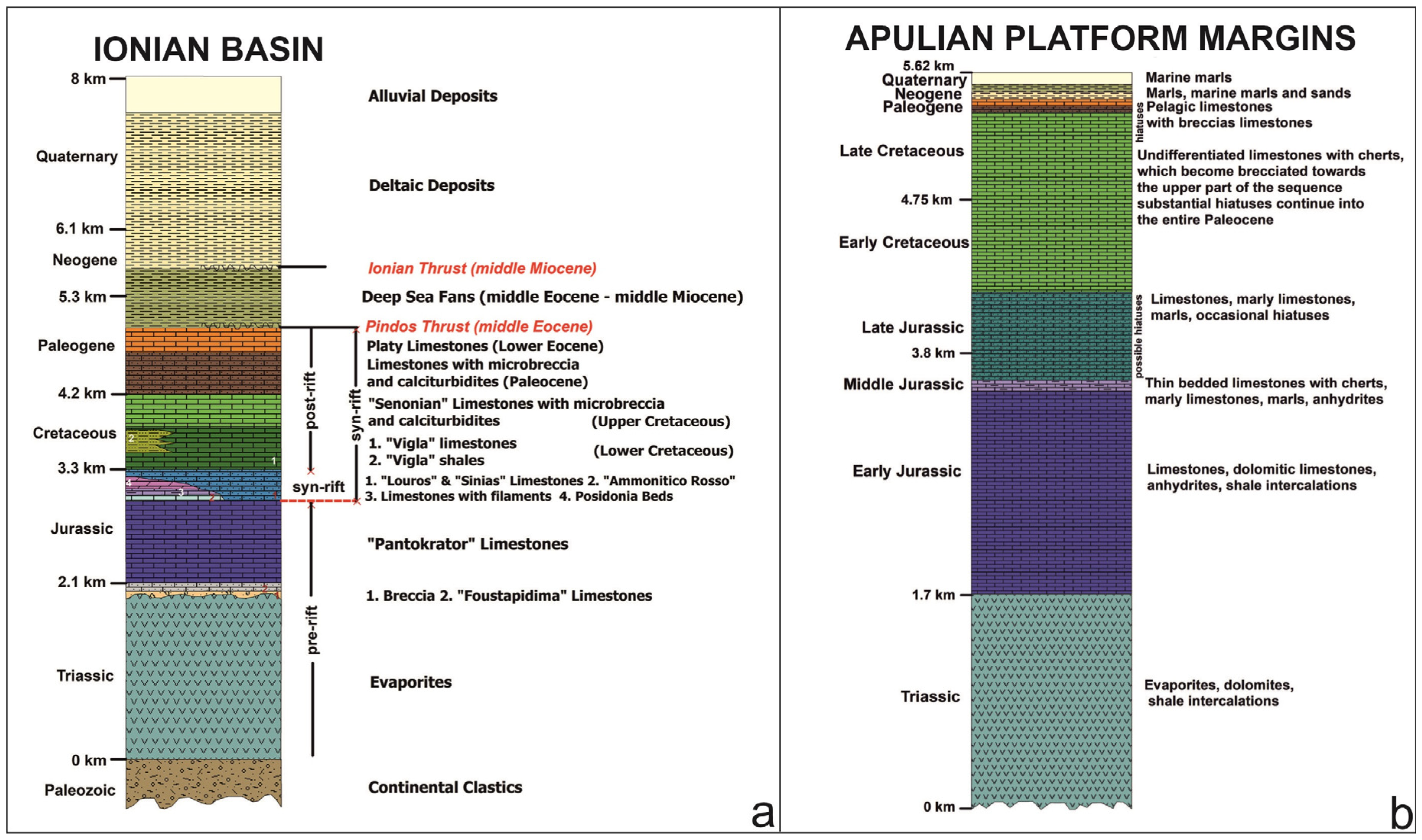
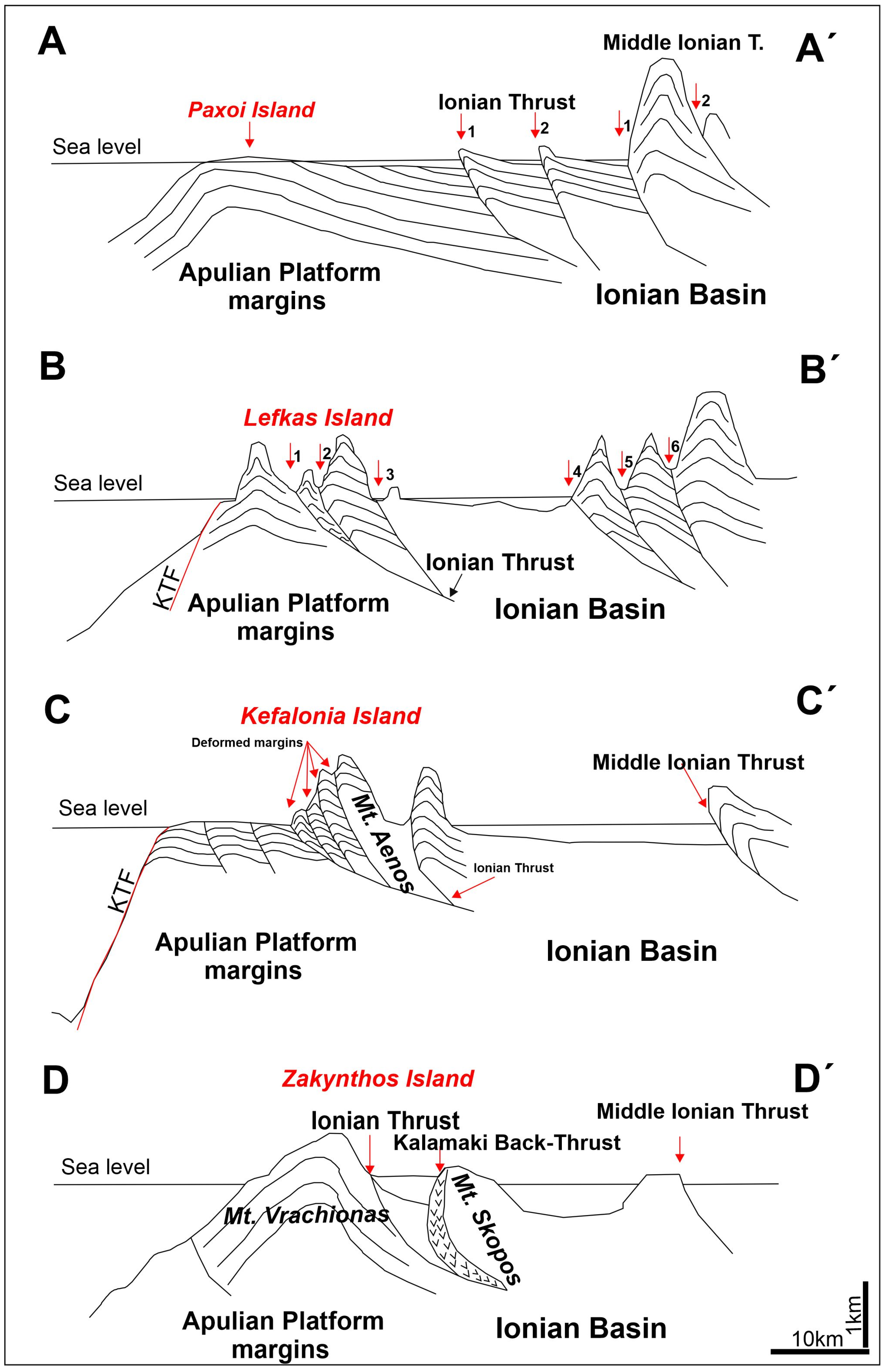

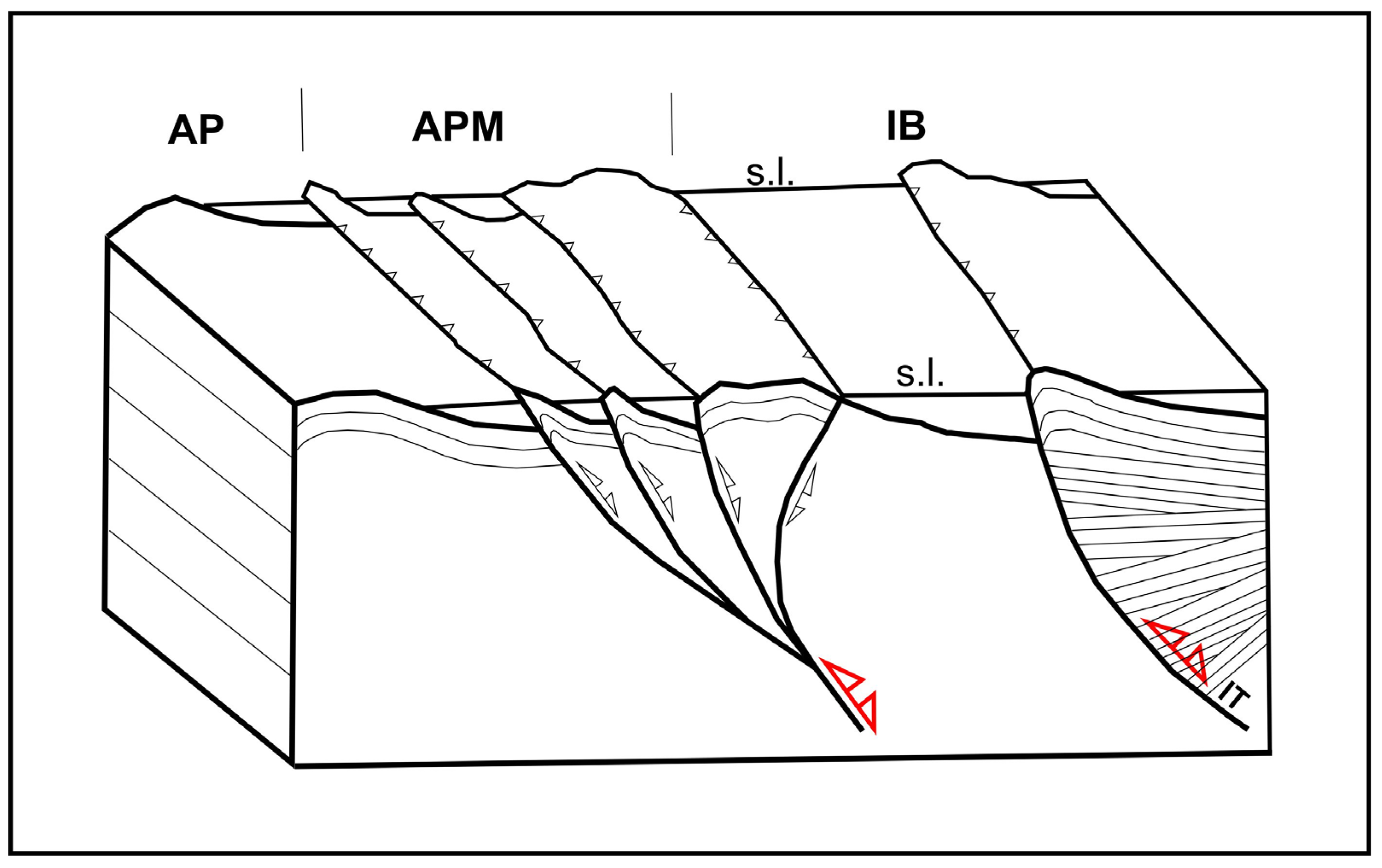
Disclaimer/Publisher’s Note: The statements, opinions and data contained in all publications are solely those of the individual author(s) and contributor(s) and not of MDPI and/or the editor(s). MDPI and/or the editor(s) disclaim responsibility for any injury to people or property resulting from any ideas, methods, instructions or products referred to in the content. |
© 2024 by the authors. Licensee MDPI, Basel, Switzerland. This article is an open access article distributed under the terms and conditions of the Creative Commons Attribution (CC BY) license (https://creativecommons.org/licenses/by/4.0/).
Share and Cite
Zelilidis, A.; Bourli, N.; Zoumpouli, E.; Maravelis, A.G. Tectonic Inversion and Deformation Differences in the Transition from Ionian Basin to Apulian Platform: The Example from Ionian Islands, Greece. Geosciences 2024, 14, 203. https://doi.org/10.3390/geosciences14080203
Zelilidis A, Bourli N, Zoumpouli E, Maravelis AG. Tectonic Inversion and Deformation Differences in the Transition from Ionian Basin to Apulian Platform: The Example from Ionian Islands, Greece. Geosciences. 2024; 14(8):203. https://doi.org/10.3390/geosciences14080203
Chicago/Turabian StyleZelilidis, Avraam, Nicolina Bourli, Elena Zoumpouli, and Angelos G. Maravelis. 2024. "Tectonic Inversion and Deformation Differences in the Transition from Ionian Basin to Apulian Platform: The Example from Ionian Islands, Greece" Geosciences 14, no. 8: 203. https://doi.org/10.3390/geosciences14080203
APA StyleZelilidis, A., Bourli, N., Zoumpouli, E., & Maravelis, A. G. (2024). Tectonic Inversion and Deformation Differences in the Transition from Ionian Basin to Apulian Platform: The Example from Ionian Islands, Greece. Geosciences, 14(8), 203. https://doi.org/10.3390/geosciences14080203










